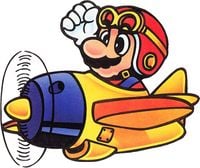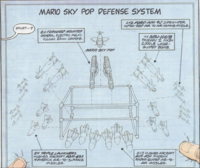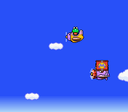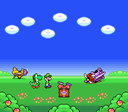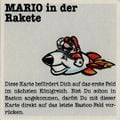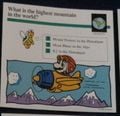Sky Pop
The Sky Pop[1] is a yellow airplane that first appeared in Super Mario Land and again in Mario & Wario.
History
Super Mario Land
The Sky Pop is used only in World 4-3 of the Chai Kingdom. It can fire missiles with unlimited ammunition. Mario uses it primarily to defeat Chickens, Biokinton, Roketons, and Tatanga. After defeating Tatanga, Mario flies off with Princess Daisy in a separate flying machine that is jet-powered and has two seats. In Japanese-exclusive media, however, this jet has been mistakenly known as the Sky Pop II.
Super Mario Land's board game adaptation, Das Super Mario Spiel, features a card depicting Mario riding a rocket, which is presumably an interpretation of the Sky Pop.
Game Boy
The Sky Pop plays a major role in the issue "Team Play" of the Game Boy limited comic book series. After Greg Campbell informs Mario of Pionpi's Pacific island fortress, Mario takes off from the USS Nimitz. As he closes by the fortress, the Sky Pop is ambushed by flying enemies, and Mario notices the island's defenses are using real-world ammunition.
Heavily damaged, Mario takes the Sky Pop back to the carrier and makes a crash landing. The plane is caught in extremis by Greg, and Mario requests to be given access to the carrier's weapons. Greg is initially reluctant, but reasons that Tatanga's forces have invaded U.S. territory by taking over the island, and draws up with Mario the "Sky Pop Defense System", a frame around the plane able to outfit a pair of Vulcan cannons, Sidewinder, Phoenix and Maverick missiles, and GBU-10E/B Paveway II laser-guided bombs. The Sky Pop takes off again (confusing two command tower operators) and Mario assaults the island fortress forces, now easily destroying them with his new weapons. Mario lands on the island and confronts Pionpi, but he soon takes off in the Sky Pop again when he learns a friendly F/A-18 Hornet from the carrier's detachment has been heavily damaged and is on course to crash with the Nimitz. From the Sky Pop, Mario grabs the left wing and manages to right the plane up, ensuring a safe landing.
The Sky Pop reappears briefly in the series' final issue, Pipes is Pipes. When Michael Hallis summons Mario from the Game Boy, Mario immediately appears piloting the Sky Pop, and uses it to fly to Clam Creek's nuclear reactor. Later, Michael's mother picks up the plane offscreen and puts it in her personal locker. After retrieving Mario from an inspector at the facility, Mario wakes up and attempts to take off with the Sky Pop to rescue Michael, but he is too weakened by his radiation exposure to fly it. Michael's mother instead puts Mario in her bag and drives home.
Super Mario Bros. Print World
Artwork of Mario riding the Sky Pop appears as one of the available designs in Super Mario Bros. Print World.
Mario & Wario
In Mario & Wario, after clearing the tenth stage, Wario Tei, the Sky Pop is used to intercept Wario and drop one of his enchanted Barrels on his head, as punishment for all of the mischief he caused to the heroes.
The Sky Pop is shown to have a conventional-type landing gear configuration, but uses a monopod instead of a tailwheel.
Super Mario (Kodansha manga)
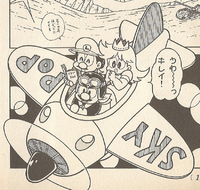
The Sky Pop appears at the end of Super Mario Land of the Super Mario manga published by KC Deluxe. It is said to have been used by Nan-chan Dōshi in his youth, who had mastered it and tells Mario that he needs to make good use of his thumb and index finger. This is later revealed to be a suggestion on how to shoot more efficiently. The plane's console is designed as a Game Boy: by shooting missiles while holding down the button and repeatedly pressing the
button, the pilot is able to shoot faster.
The plane reappears in the beginning of the Super Mario World 1 volume. Here, Mario, Luigi, and Princess Peach use it to land on an island for their vacation.
Mario Quiz Cards
The Sky Pop appears in artwork for one of the cards in the "Geography" category of the Mario Quiz Cards, specifically the card "What is the highest mountain in the world?".
Yoshi's Woolly World / Poochy & Yoshi's Woolly World
Yoshi has a transformation based on the Sky Pop in Yoshi's Woolly World and Poochy & Yoshi's Woolly World, known as Sky Pop Yoshi. It controls similarly to the Sky Pop's appearance in Super Mario Land.
Super Mario Maker
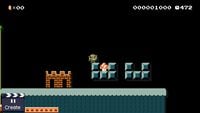
A Costume Mario costume based on the original sprite of Super Mario piloting the Sky Pop appears in Super Mario Maker. The costume was officially released on January 6, 2016, and can be unlocked by completing the "Southwest Air Adventure" Event Course. All of the costume's sound effects and fanfares (transformation, jumping, clearing a course, and losing a life) are taken from Super Mario Land. Pressing up on the ![]() causes Mario's legs to appear from under the plane and face the screen, playing the sound for collecting a coin from Super Mario Land.
causes Mario's legs to appear from under the plane and face the screen, playing the sound for collecting a coin from Super Mario Land.
Official profiles
Super Mario Land
- Virtual Console Manual: "Mario flies through the air in this missile-armed airplane."
Gallery
Kellogg's trading card
Names in other languages
| Language | Name | Meaning |
|---|---|---|
| Japanese | スカイポップ号[2] Sukaipoppu-gō |
Sky Pop machine |
| Dutch | Sky Pop[3] |
- |
| German | Rakete |
Rocket |
| Italian | Sky Pop |
- |
| Russian | Неболет Nyebolyot |
Skyflier |
| Spanish | Sky Pop Pop Celestial[5] |
- Celestial Pop |
References
| Super Mario Land | |
|---|---|
| Protagonists | Mario • Princess Daisy |
| Bosses | King Totomesu • Dragonzamasu (Tamao) • Hiyoihoi • Biokinton (Chicken) • Tatanga (Pagosu) |
| Locations | Sarasaland (Birabuto Kingdom • Muda Kingdom • Easton Kingdom • Chai Kingdom) |
| Levels | World 1-1 • World 1-2 • World 1-3 • World 2-1 • World 2-2 • World 2-3 • World 3-1 • World 3-2 • World 3-3 • World 4-1 • World 4-2 • World 4-3 • Expert Level |
| Items & vehicles | Super Mushroom • Superball Flower • Star • 1UP heart • Coin • Marine Pop • Sky Pop • Switch • Lift Block |
| Enemies & obstacles | Batadon • Bombshell Koopa • Bullet Biff • Bunbun • Chikako • Dropping lift • Falling block • Falling spike • Fly • Ganchan • Gao • Gunion • Goombo • Honen • Kumo • Mekabon • Nyololin • Pionpi • Pipe Fist • Piranha Plant • Pompon Flower • Roketon • Roto Disc • Suu • Tokotoko • Torion • Yurarin • Yurarin Boo |
| Other | Brick • Bonus game • Das Super Mario Spiel • Gallery • Glitches • Goal • Media • Mystery Block • Soundtrack |
